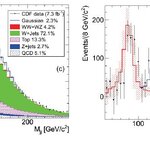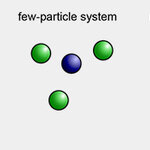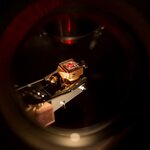Physics

The results of the LUX experiment are out - and they are negative: no dark matter signal has been spotted by the extra sensitive detector. This is a normal day for you and me, but a gloomy day for those that counted on the neutralino to be the first supersymmetric particle to show up and redeem decades of claims.
Flippant comments aside, the experiment is a technological marvel. Located one mile underground at Sanford Laboratory, it is a water-shielded tank containing 250 kg of liquid xenon as active material. The deep underground location, combined with the exceptional purity of the xenon…

The Large Underground Xenon (LUX) experiment is trying to identify the nature of dark matter, an invisible substance that physicists believe is all around us, making up most of the matter in the universe, even though it has effect on our lives.
The umbrella term 'dark matter' encompasses about 25% of the Universe, while what we know as matter makes up about 5%. The rest consists of what is called "dark energy" and no one knows anything about that other than that it is something helps make gravity behave strangely at the very large scale.
The first results are to validate the LUX experiment's…

Do you remember the dijet bump at 140 GeV that CDF published in March 2011 ? This was a surprising excess in the mass distribution of pairs of jets found in events containing a leptonic W boson decay.
The analysts had been searching for semileptonic WW pair production (that is, events where one W decays to a electron-neutrino or muon-neutrino pair, and the other decays to a quark-antiquark pair, thereby producing a dijet signature). As they studied the dijet mass distribution in search for the W->jj signal, in addition to that they observed a mis-modeling of the high-mass tail of the…

At some point the exact number of particles in a group becomes irrelevant.
But does when a collection of elements forms a "heap"
?
In recent experiments using ultracold atoms, Heidelberg physicists succeeded in observing the transition to a many-body system well described by an infinite number of particles - a problem philosophers call the sorites paradox. The essential question is when a collection of elements forms a "heap".
"Systems comprising many particles are generally extremely difficult to describe in a microscopically exact way. Hence researchers tend to work with effective…

Just a quick link today, to acknowledge an interesting report on the life of physics students in Greece and the present situation with Universities there. And of course, if you wish to practice your Greek, there are more articles there, translated for us by Yiannis Michaloliakos.

Researchers have made a step toward the creation of materials that can be 'tuned' just by shining a light on them - they have succeeded in producing and measuring a coupling of photons and electrons on the surface of an unusual type of material called a topological insulator. This type of coupling had been predicted by theorists but never observed.
Their method involves shooting femtosecond (millionths of a billionth of a second) pulses of mid-infrared light at a sample of material and observing the results with an electron spectrometer, a specialized high-speed camera the team developed.…

"The question is not whether these boards will catch fire or not. The question is when they will".
(Said by Fermilab electronics experts who were members of a review panel that provided advice on the construction of a prototype of fast-tracker hardware boards that had been designed for CDF for Run I. The boards were meant to process online data from the CDF tracker at trigger level 2. The boards were redesigned and eventually worked very reliably (no fires!)).

Yesterday evening I chanced to attend, invited by a friend, the opening of the 2013-2014 academic year of the university of Venice "Ca' Foscari", which was held at the Malibran theater. It was the first time I attended one such event, since technically (and practically) I am not an academic, but a researcher at the INFN, the Italian National Institute of Nuclear Physics. I do occasionally teach university courses (I just took a break from doing so after 5 years of teaching a course of subnuclear physics for 5th year undergraduates); but I do that for the university of Padova, not Venice - my…

Please note: spoiler information in this article!
The recent movie "Gravity", featuring the two hollywood stars George Clooney and Sandra Bullock, is a very interesting experiment in film-making.
I can hardly recall other movies with just two characters, so this must clearly be a rare occurrence and one which shows that the movie treads in largely unexplored territory. Can people be entertained by one-man shows ? Well, yes, if the story is an extraordinary one. Tom Hanks does excellently in "Cast Away", for instance. "Gravity" is similar in the use of the loneliness of the protagonist and…

To many the label "scientist" has a residue of meaning a certain kind of white male. Western society in particular loves labels and loves to put people in tiny boxes. This story is about the social consequence of violating the norm of western society in regards to who fits the label "scientist".
The incident that caused a million clacking keyboards in the science blogosphere involved Sci Am blogger Danielle N. Lee being called a "Urban Whore" when she refused to blog for free at another publication. The quote from someone identified only as 'Ofek' who worked for…